Read "DTC Status" parameter.
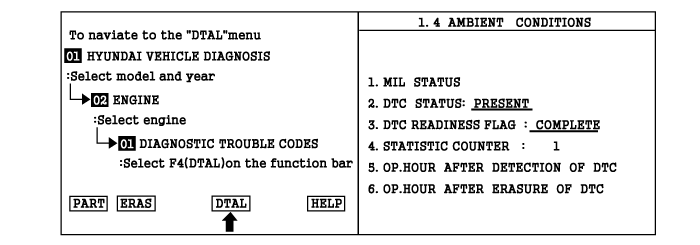
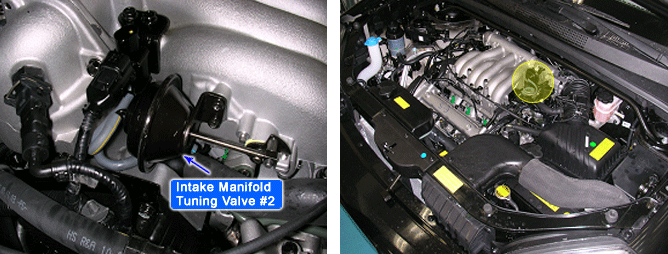
Intake manifold tuning valve is used to increase torque at lower rpm and increase horsepower at higher rpm. Delta 2.7ℓ engine has two intake runners for each cylinder. The primary intake runner is a long, thin tube in which the intake air passes through. This allows a strong stream of air to blast into the cylinder, helping low-end torque. The secondary intake runner is a short, fat tube. This allows a large volume of air to be sucked into the engine, increasing high-end horsepower. At lower rpm range, the engine does not provide enough suction into the cylinders, starving the engine of much needed oxygen. The skinny tube helps blast the air into the cylinder for more oxygen. At higher rpm, the engine has plenty of suction but the intake runner is too small to provide the oxygen it needs. The short, fat tube allows plenty of oxygen to be sucked in. The ECM controls this function utilizing a intake manifold tuning valve. Based on engine RPM, the position of the shutter within the intake manifold is changed, thereby directing intake air through a longer path for low rpm range or a shorter path for high rpm range.
ECM sets DTC P0664 if the ECM detects that intake manifold tuning valve control circuit is shorted to ground.
ITEM | DETECTING CONDITION | POSSIBLE CAUSE |
DTC Strategy | ● Driver Stage Check | ● Open in power supply harness ● Short to ground in control harness ● Contact resistance in connectors ● Faulty valve |
Enable Conditions | ● 10 〈 Battery voltage(V) 〈16 ● Engine speed(rpm) 〉30 | |
Threshold Value | ● Short to ground | |
Diagnostic Time | ● 1.5 sec. |
Temperature | Resistance (Ω) | |
(℃) | (℉) | |
20 | 68 | 29~35 |
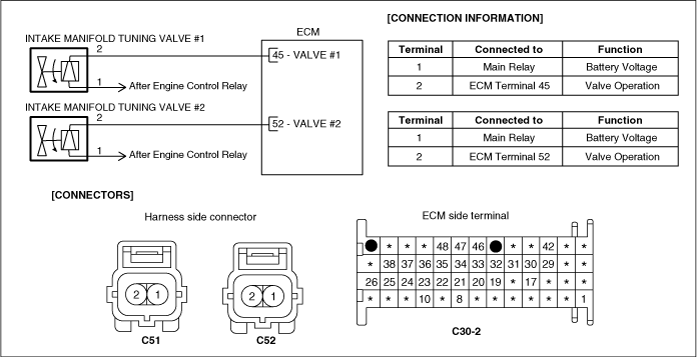
Connect scan tool and select "Diagnostic Trouble Codes(DTCs)" mode.
Press F4(DTAL) to select DTC information from the DTCs menu.
Confirm that "DTC Readiness Flag" indicates "Complete". If not, drive the vehicle within conditions noted in the freeze frame data or enable conditions
Read "DTC Status" parameter.

Is parameter displayed "History(Not Present) fault"?
History (Not Present) fault : DTC occurred but has been cleared.
Present fault : DTC is occurring at present time.

▶ Fault is intermittent caused by poor contact in the sensor's and/or ECM's connector or was repaired and ECM memory was not cleared. Thoroughly check connectors for loose or poor connections, bending, corrosion, contamination, deterioration, or damage. Repair or replace as necessary and go to "Verification of Vehicle Repair" procedure.

▶ Go to "Component Inspection" procedure.
Many malfunctions in the electrical system are caused by poor harness(es) and terminals. Faults can also be caused by interference from other electrical systems, and mechanical or chemical damage.
Thoroughly check connectors for looseness, poor connection, bending, corrosion, contamination, deterioration, or damage.
Has a problem been found?

▶ Repair as necessary and go to "Verification of Vehicle Repair" procedure.

▶ Go to "Power Supply Circuit Inspection" procedure.
Ignition "ON" & Engine "OFF".
Measure voltage between terminal 1 of the valve harness connector and chassis ground.
Specification : Approx. B+

Is voltage within the specification?

▶ Go to "Control Circuit Inspection"

▶ Check for open or blown SNSR Fuse(2).
Repair as necessary and go to "Verification of Vehicle Repair" procedure
Check for short to ground in control circuit.
Ignition "OFF".
Measure resistance between terminal 2 of the valve harness connector and chassis ground
Specification : Infinite
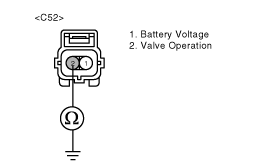
Is resistance within the specification?

▶ Check for poor connection between ECM and component: backed out terminal, improper mating, broken locks or poor terminal to wire connection. Repair as necessary and go to "Verification Vehicle Repair" procedure

▶ Repair open or short to ground in control harness and go to "Verification of Vehicle Repair" procedure.
Ignition "OFF".
Disconnect valve connector.
Measure resistance between terminals 1 and 2 of the valve connector(Component side).
Specification : Approx. 29~35Ω at 20℃(68℉)
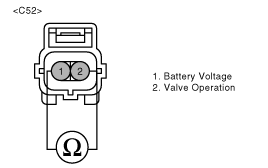
Is resistance within the specification?

▶ Go to next step as below.

▶ Check valve for contamination, deterioration, or damage. Substitute with a known-good valve and check for proper operation. If the problem is corrected, replace valve and then go to "Verification of Vehicle Repair" procedure
After a repair, it is essential to verify that the fault has been corrected.
Connect scan tool and select "Diagnostic Trouble Codes(DTCs)" mode.
Press F4(DTAL) and confirm that "DTC Readiness Flag" indicates "Complete". If not, drive the vehicle within conditions noted in the freeze frame data or enable conditions.
Read "DTC Status" parameter.
Is parameter displayed "History(Not Present) fault"?

▶ System performing to specification at this time. Clear the DTC

▶ Go to the applicable troubleshooting procedure.